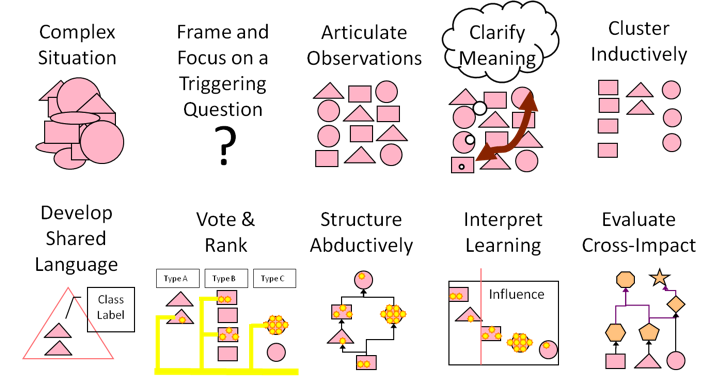Structured Dialogic Design Process: Difference between revisions
No edit summary |
Anthodesmia (talk | contribs) (added stakeholders) |
||
| (8 intermediate revisions by 2 users not shown) | |||
| Line 1: | Line 1: | ||
The '''Structured Democratic Dialogue Process''', also referred to as [[Structured Design Process]], is an implementation of a [[Co-Laboratory]] in strict compliance with the [[Foundational Axioms of Dialogic Design Science| Foundational Axioms ]] and [[Laws of Dialogic Design Science|Laws]] of [[Dialogic Design Science]]. | |||
[[File:SDDP_Phases.png|left | ==The Broker makes the first move== | ||
==Setting up a Knowledge Management Team== | |||
==Formulating the Triggering Question== | |||
==Selecting the appropriate stakeholders== | |||
The KMT is responsible for choosing the minimum number of individuals who represent the maximum possible variety of stakeholders. The [[Law of Requisite Variety]] demands that the variety of those participating should be equal to the variety that exists in the real-world system. In simple terms, those invited to join a dialogue must represent all possible diverse and or conflicting points of view, opinions, or interests. A stakeholder is defined as any entity that has a stake in any potential changes to the system; i.e., those whose lives will be influenced by any changes in the system. These include non-human entities such as animals and the environment at large. The interests of the latter could be represented by people who work for relevant NGOs or other analogous organizations. | |||
[[File:SDDP_Phases.png|left|upright=1|alt=Logo.|Graphical illustration of the phases of a typical SDDP]] | |||
| Line 8: | Line 21: | ||
==External links== | ==External links== | ||
*[ | *[https://www.coe.int/en/web/culture-and-heritage/structured-democratic-dialogue-process] | ||
[[Category:Dialogic Design Science]] | |||
Latest revision as of 00:43, 18 September 2024
The Structured Democratic Dialogue Process, also referred to as Structured Design Process, is an implementation of a Co-Laboratory in strict compliance with the Foundational Axioms and Laws of Dialogic Design Science.
The Broker makes the first move
Setting up a Knowledge Management Team
Formulating the Triggering Question
Selecting the appropriate stakeholders
The KMT is responsible for choosing the minimum number of individuals who represent the maximum possible variety of stakeholders. The Law of Requisite Variety demands that the variety of those participating should be equal to the variety that exists in the real-world system. In simple terms, those invited to join a dialogue must represent all possible diverse and or conflicting points of view, opinions, or interests. A stakeholder is defined as any entity that has a stake in any potential changes to the system; i.e., those whose lives will be influenced by any changes in the system. These include non-human entities such as animals and the environment at large. The interests of the latter could be represented by people who work for relevant NGOs or other analogous organizations.
